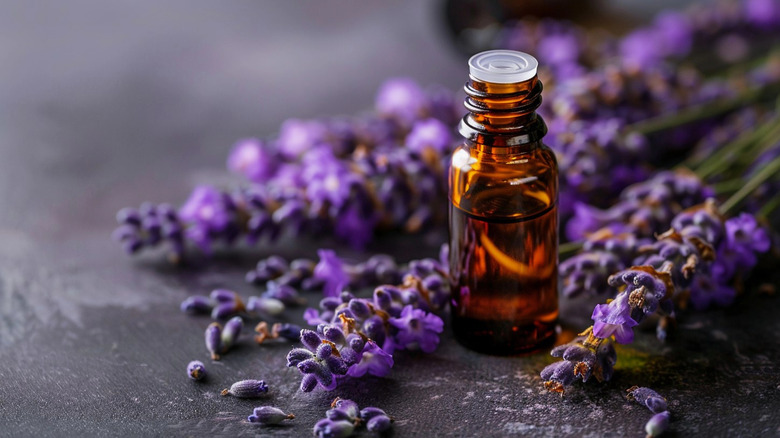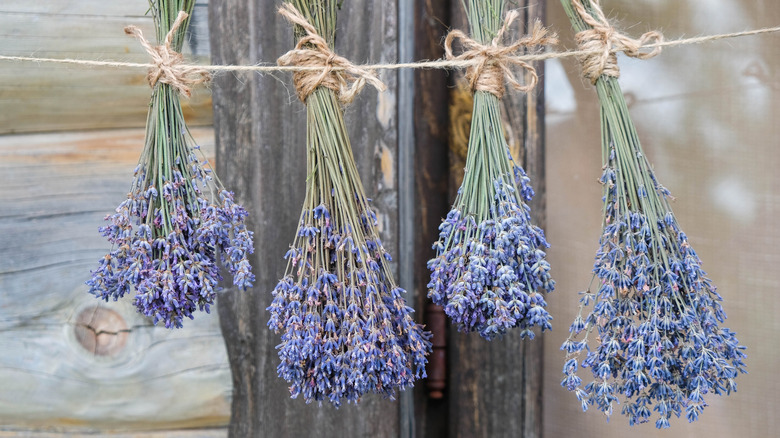How To Use Lavender Oil To Transform An Outdoor Space Into A Bug-Free Zone
Dealing with bugs in the garden can be frustrating, especially when you're trying to avoid harsh chemical sprays. You want something simple, safe, and pleasant to use. That's where lavender oil comes in. While more research is needed to fully understand its impact, several studies suggest that lavender oil may help repel ants, mosquitoes, moths, spiders, termites, and even scorpions. These bugs tend to avoid areas with strong-smelling oils, including lavender.
To put it to work in your garden, try adding a few drops to cotton balls and tucking them into planters, or mix it with water and spray it around high-traffic bug zones. The scent of this oil may mask the chemical cues that insects use to locate hosts or interfere with the pheromone trails ants follow to search for food. Lavender oil might not tackle major infestations, but if you're aiming for a gentle, low-impact solution that keeps your garden more comfortable, it's a great place to start.
Safe and effective ways to use lavender oil outdoors
Lavender oil can be helpful as a homemade insect repellent, but it's important to use it the right way to avoid damage to plants or skin irritation during application. One of the simplest ways to use it is by creating a natural spray. Combine about 2 cups of water with 20 drops of lavender essential oil and 10 drops of tea tree oil in a spray bottle.
Shake well before each use, then spray it around garden beds, planters, patios, and seating areas, focusing on spots where bugs tend to gather. It's also important to dilute the solution properly, as undiluted or overly strong lavender oil can damage plant leaves. Since oils evaporate fast, this spray will only remain effective for a few hours. You'll need to reapply it regularly to keep pests at bay.
Always wear gloves when handling essential oils to avoid direct skin contact. Even though they're natural, concentrated oils can sometimes irritate the skin or cause allergic reactions. Another method is to soak a few cotton balls with lavender oil and place them near garden entry points, tucked into pots, or around windows and doors. However, if your garden is dealing with a serious infestation, it's best to contact a pest control professional.
How to make lavender oil at home
If you're growing lavender outdoors, you can make your own lavender-infused oil using just a few simple tools and a bit of patience. Start by gathering fresh lavender that's either in bloom or just before full bloom. Cut the stems at least 6 inches long and bundle them together. Suspend the bundle upside down in a warm, arid space with good airflow, and leave it to dry for about two weeks or a month.Once dry, place the lavender flowers in a clean glass jar, leaving about a quarter of the space empty. Gently crush them to release the oils.
Pour in a carrier oil until the lavender is completely submerged and moves freely – olive oil, coconut oil, or almond oil are all good options. Close the jar tightly and place it on a sunny windowsill. Let it infuse for up to three weeks, giving the jar a gentle shake every couple of days. When the oil smells strongly of lavender, strain out the plant material using a cheesecloth. Pour the finished oil into a clean glass bottle and store it somewhere damp, with no light. This DIY oil in diluted form works well for garden sprays or cotton ball applications and gives you full control over what goes into your repellent.


